
Italian Village is a neighborhood in Columbus, Ohio, that contains an array of residential, commercial, and industrial buildings. It is a designated historic district, known for its historical and cultural preservation. The building types and architecture reflect Italian influence. With its parks and preserved historic homes, Italian Village has the highest home value appreciation in Columbus.
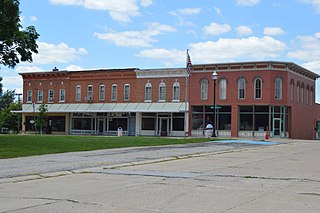
Barry Historic District is a historic district comprising the commercial and older residential areas of Barry, Pike County, Illinois. Barry was founded as an agricultural community in the 1830s, and most of its development took place between its founding and the Civil War. The city's commercial core, however, was mainly built in 1894 after a fire destroyed most of the existing commercial buildings. The 1894 buildings are well-preserved examples of typical commercial architecture of the period, and several have metal storefronts. The district also includes Barry's "Diamond Hill" residential district on Mortimer Street east of Brown Street and several other residential sections. Prominent architectural styles in the residential areas include Italianate, Queen Anne, Carpenter Gothic, and vernacular types from the late 19th century.
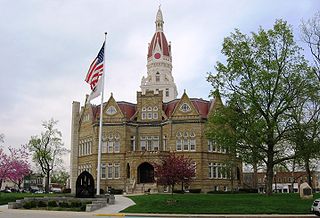
Pittsfield Historic District is a historic district in Pittsfield, Illinois, the county seat of Pike County. The district is centered on the Pike County Courthouse and the surrounding courthouse square; it also encompasses nearby residential areas. The courthouse was built in 1894–95; architect Henry Elliott based its Romanesque design off his earlier design for the Edgar County, Illinois, courthouse. The district's historic commercial buildings are mostly located on the courthouse square, which surrounds the courthouse; these buildings are mainly two-story brick structures. The Italianate and Queen Anne styles are prevalent among the district's houses, with the former being the most prominent; the Greek Revival and Federal styles are also common in the district's earlier homes.
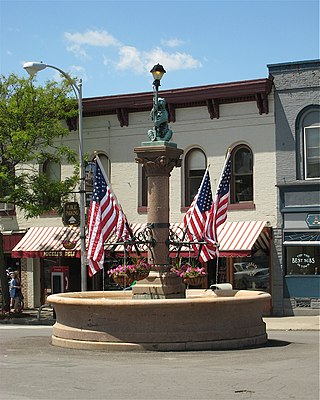
The Geneseo Historic District, previously known as the Main Street Historic District, is a historic district encompassing much of the village center of Geneseo, New York. Geneseo has a remarkably well-preserved 19th-century streetscape, with Victorian architecture embodying a picturesque style advocated by architect Andrew Jackson Downing. The district was listed on the National Register of Historic Places in 1977; an enlarged district was designated a National Historic Landmark in 1991.

The South Central Falls Historic District is a historic district in Central Falls, Rhode Island. It is a predominantly residential area, densely populated, which was developed most heavily in the late 19th century. It is bounded roughly by Broad Street to the east, the Pawtucket city line to the south, Dexter Street to the west, and Rand Street and Jenks Park to the north. It has 377 contributing buildings, most of which were built before 1920. The district was added to the National Register of Historic Places in 1991.
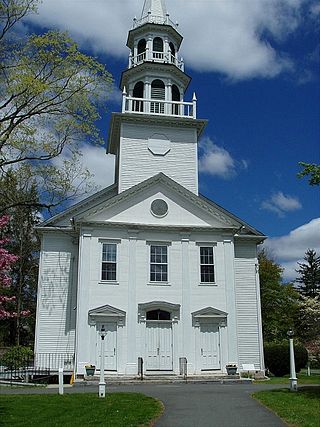
The South Britain Historic District encompasses the core of the unincorporated village of South Britain in Southbury, Connecticut, United States. The village arose in the 18th century as an industrial center serving the surrounding agricultural community, powered by the Pomperaug River, and rivalled the town center of Southbury in importance. The district was listed on the National Register of Historic Places in 1987.

Glenville Historic District, also known as Sherwood's Bridge, is a 33.9 acres (13.7 ha) historic district in the Glenville neighborhood of the town of Greenwich, Connecticut. It is the "most comprehensive example of a New England mill village within the Town of Greenwich". It "is also historically significant as one of the town's major staging areas of immigrants, predominantly Irish in the 19th century and Polish in the 20th century" and remains "the primary settlement of Poles in the town". Further, "[t]he district is architecturally significant because it contains two elaborate examples of mill construction, designed in the Romanesque Revival and a transitional Stick-style/Queen Anne; an excellent example of a Georgian Revival school; and notable examples of domestic and commercial architecture, including a Queen Anne mansion and an Italianate store building."

The Central Troy Historic District is an irregularly shaped, 96-acre (39 ha) area of downtown Troy, New York, United States. It has been described as "one of the most perfectly preserved 19th-century downtowns in the [country]" with nearly 700 properties in a variety of architectural styles from the early 19th to mid-20th centuries. These include most of Russell Sage College, one of two privately owned urban parks in New York, and two National Historic Landmarks. Visitors ranging from the Duke de la Rochefoucauld to Philip Johnson have praised aspects of it. Martin Scorsese used parts of downtown Troy as a stand-in for 19th-century Manhattan in The Age of Innocence.

There are nine historic districts in Meridian, Mississippi. Each of these districts is listed on the National Register of Historic Places. One district, Meridian Downtown Historic District, is a combination of two older districts, Meridian Urban Center Historic District and Union Station Historic District. Many architectural styles are present in the districts, most from the late 19th century and early 20th century, including Queen Anne, Colonial Revival, Italianate, Art Deco, Late Victorian, and Bungalow.
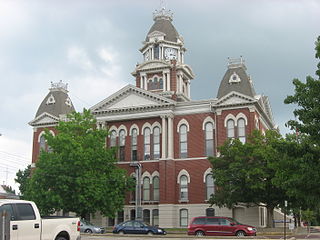
The Shelbyville Historic District is a historic district encompassing the core of Shelbyville, Illinois. The district includes 398 buildings, 293 of which are contributing buildings. The section of Shelbyville laid out at the city's founding in 1827 forms the center of the district. Shelbyville's public square, which includes the 1880 Shelby County Courthouse and a veterans' memorial, is the central feature of this part of the historic district. The original section of Shelbyville also includes significant commercial and government buildings. The district also includes Shelbyville's oldest residential areas, which developed out from the 1827 core. The Italianate style is the most prominent architectural style in the district, both in homes and commercial buildings; other common architectural styles include Greek Revival, Gothic Revival, Second Empire, and Queen Anne.
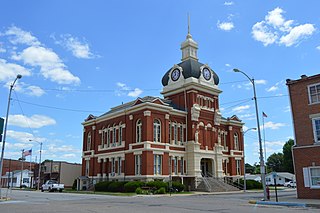
The Winchester Historic District is a historic district which encompasses much of the developed area of Winchester, Illinois. The district includes 438 buildings, of which 273 are contributing buildings. Winchester's historic area represents a typical small, rural county seat; its commercial development is focused around the county courthouse and town square, while low- to moderate-density residential development can be found away from the commercial center. Development in the district began in the 1830s; by the 1870s, most of the significant buildings had been completed. The district's older buildings are mainly designed in the Federal and Greek Revival styles, while its later buildings mostly have Italianate designs. The Greek Revival Presbyterian Church stands out among these traditionally-styled buildings; according to the Illinois Historic Structures Survey, it is the most exceptional Greek Revival church in any Illinois city of over 500 people. The Scott County Courthouse, a late addition to the district in 1885, has also been noted as architecturally significant, though its design does not conform to a single style.

The Fair Haven Green Historic District encompasses the village green of Fair Haven, Vermont, and the heterogeneous collection of civic, commercial, and residential buildings that line it and adjacent streets. The area was developed mainly following the arrival of the railroad in 1848 and the subsequent expansion of marble and slate quarries in the area. The district was listed on the National Register of Historic Places in 1980.

The Poultney Main Street Historic District encompasses the commercial and residential historic core of the village of Poultney, Vermont. Centered on Main Street and East Main Street, between College Avenue and St. Raphael's Catholic Church, the district includes a diversity of architectural styles, as well as civic, religious, and commercial functions spanning a period of more than 100 years. The district was listed on the National Register of Historic Places in 1988.

The Wallingford Main Street Historic District encompasses the historic portions of the village of Wallingford, Vermont. An essentially linear district extending along Main Street on either side of School Street, it has a well-preserved array of 19th and early-20th century residential, commercial, and civic buildings. It was listed on the National Register of Historic Places in 1984.

The Plainfield Village Historic District encompasses a significant portion of the village of Plainfield, Vermont. Located in northernmost Plainfield on United States Route 2, the village grew in the 19th century as a mill town and service community for the surround agricultural areas, and has a well-preserved collection of Greek Revival and Italianate architecture. It was listed on the National Register of Historic Places in 1983.

The Morrisville Historic District encompasses most of the historic commercial downtown area of the village of Morrisville in Morristown, Vermont. Developed in the early 19th century as a service town for the surrounding agricultural areas, it was transformed into a major service regional commercial center by the arrive of the railroad in 1872. Its surviving architecture is largely reflective of these two time periods. It was listed on the National Register of Historic Places in 1983, and enlarged in 2007.

The Upper Iowa Street Historic District is a nationally recognized historic district located in Dubuque, Iowa, United States. It was listed on the National Register of Historic Places in 2015. At the time of its nomination it consisted of nine resources, which included eight contributing buildings and one non-contributing building. The district is a single block with commercial and residential buildings on both sides of Iowa Street. It was originally a residential section on the north side of the central business district. The first two commercial buildings were substantial Italianate-style structures constructed on the north side of the block in the mid-1880s. In the 1890s larger and more elaborate Queen Anne commercial buildings were built to the south. The oldest building is an 1872 residence that was used as a doctor's office and other business purposes. It has subsequently been covered in Permastone. The rest of the buildings are brick with stone ornamentation.

The Federal Hill Historic District encompasses a predominantly residential area of Bristol, Connecticut, known for its high-quality 19th and early 20th-century residential architecture. Centered around the Federal Hill Green, it developed as a fashionable residential area, and features a large number of fine Italianate and Victorian houses. It was listed on the National Register of Historic Places in 1986.
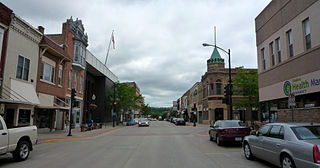
The Decorah Commercial Historic District is a nationally recognized historic district located in Decorah, Iowa, United States. It was listed on the National Register of Historic Places in 2017. At the time of its nomination it contained 126 resources, which included 85 contributing buildings, one contributing structure, and 40 non-contributing buildings. The historic district covers most of the city's central business district. Water Street, which is a major thoroughfare through the district was named after a millrace (non-extant) that rerouted water from the Upper Iowa River to serve the needs of the mills and the commercial district. The land here is relatively flat and allowed for a linear shopping area. The Broadway–Phelps Park Historic District is largely a residential area that is located to the south.
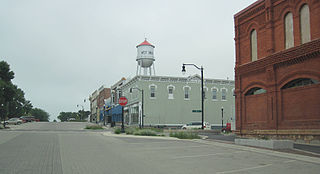
The West Union Commercial Historic District is a nationally recognized historic district located in West Union, Iowa, United States. It was listed on the National Register of Historic Places in 2015. At the time of its nomination the district consisted of 56 resources, including 38 contributing buildings, one contributing structure, and 17 noncontributing buildings. West Union was platted in 1850 and retail businesses began the same year around the public square. The square also served as the center for county government and as a place for many of the community's social activities. The wide streets and sidewalks in the central business district also facilitated the city's commercial and social life. The buildings in the district have housed various commercial businesses, government operations, and churches. The residential buildings are mostly associated with the churches. Most of the buildings are one and two-stories in height, although a couple are three-stories, and built of brick. Most of them are in the revival styles built in the Victorian era, including Italianate, Queen Anne, Neoclassical, and Colonial Revival. There are also buildings designed in the Commercial style. Several buildings were designed by architects, but for the most part the designers are unknown. The city's water tower is the contributing structure. The First Baptist Church (1867), Hobson Block (1885), Maple View Sanitarium (1903), and the Fayette County Courthouse (1923) are all individually listed on the National Register of Historic Places.























